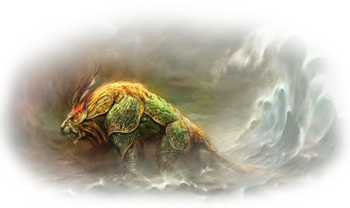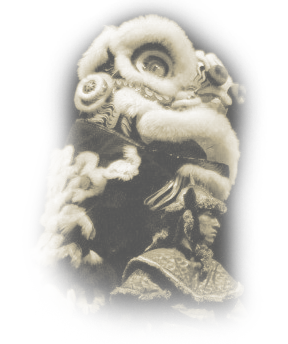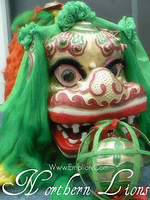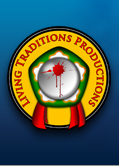Please keep your comments appropriate.
 One of the most prolific legends explaining the origin of Lion Dance is that of the mischievous Lion who wrought havoc, mayhem, trouble, and general irritation with his propensity for practical jokes and pranks. On one occasion, the lion made the fatal mistake of deciding to play a practical joke on the Jade Emperor. Angered by all the trouble the lion caused, The Jade Emperor struck down the Lion and cut his head off. He then threw both the lion's head and body down to the earth to rot. Upon discovering the fate of the lion, Kwan Yin (the goddess of mercy) took pity on the Lion and decided to help him. She used a long red ribbon to tie the lion's head back on and return him to life. Kwan Yin then adorned the lion with a horn and mirror to turn the Lion into a creature for goodness. The red ribbon is still seen today and, along with the mirror and the horn, is said to have the ability to ward off evil spirits.
One of the most prolific legends explaining the origin of Lion Dance is that of the mischievous Lion who wrought havoc, mayhem, trouble, and general irritation with his propensity for practical jokes and pranks. On one occasion, the lion made the fatal mistake of deciding to play a practical joke on the Jade Emperor. Angered by all the trouble the lion caused, The Jade Emperor struck down the Lion and cut his head off. He then threw both the lion's head and body down to the earth to rot. Upon discovering the fate of the lion, Kwan Yin (the goddess of mercy) took pity on the Lion and decided to help him. She used a long red ribbon to tie the lion's head back on and return him to life. Kwan Yin then adorned the lion with a horn and mirror to turn the Lion into a creature for goodness. The red ribbon is still seen today and, along with the mirror and the horn, is said to have the ability to ward off evil spirits.
 The fabled events of The Lion and The Nien took place around 2697 B.C. during the reign of the legendary Yellow Emperor. A strange creature appeared one day in the Yellow Emperor's villages and preyed on both men and beasts. This creature's name was Nien, which sounds like the Chinese word that means "year." The Nien was so fast and so fierce that not even the ox nor tiger could slay him. The people turned to the lion for help in despair. Rushing to meet the terrible foe, the lion "expanded his chest, raised his mighty head, shook his mane" and wounded the creature who "went running off with its tail between his legs." As the Nien fled, it turned and screamed, "Beware! I will return and take my revenge!"
The fabled events of The Lion and The Nien took place around 2697 B.C. during the reign of the legendary Yellow Emperor. A strange creature appeared one day in the Yellow Emperor's villages and preyed on both men and beasts. This creature's name was Nien, which sounds like the Chinese word that means "year." The Nien was so fast and so fierce that not even the ox nor tiger could slay him. The people turned to the lion for help in despair. Rushing to meet the terrible foe, the lion "expanded his chest, raised his mighty head, shook his mane" and wounded the creature who "went running off with its tail between his legs." As the Nien fled, it turned and screamed, "Beware! I will return and take my revenge!"
As promised, Nien returned a year later, but the lion was too busy guarding the emperor's gate to help and so the villagers hurriedly took some bamboo and cloth to make an image of the lion. Two men crawled inside and made it run, prance, and roar. Faced with this awesome creature, the Nien again turned and fled. And so, on the eve of each Chinese New Year, lions always dance to send menace and evil away for yet another year of luck and good tidings.
 A popular belief is that the lion dance finds its roots in the Tang Dynasty (AD 618-906). Legend has it that the emperor had a strange dream one night. In his dream, an odd creature he had never laid eyes upon before saved his life and carried him to safety. The next day, wondering what this creature was and what the dream meant, the emperor described his reverie to his ministers. One of the ministers explained that the strange creature resembled an animal called a "lion", which did not exist in China at the time. The emperor, wanting to see this "lion" while awake, ordered them to create a model of it, and because of his dream, the lion came to symbolize good luck, happiness, and prosperity.
A popular belief is that the lion dance finds its roots in the Tang Dynasty (AD 618-906). Legend has it that the emperor had a strange dream one night. In his dream, an odd creature he had never laid eyes upon before saved his life and carried him to safety. The next day, wondering what this creature was and what the dream meant, the emperor described his reverie to his ministers. One of the ministers explained that the strange creature resembled an animal called a "lion", which did not exist in China at the time. The emperor, wanting to see this "lion" while awake, ordered them to create a model of it, and because of his dream, the lion came to symbolize good luck, happiness, and prosperity.
During the North and South Dynasties (AD 420 - 589), the Emperor Wen from the Song province invaded the territory of Lin-yi. His governor, Tan He, was in a dilemma as to how his army would defeat Lin-yi's strong platoon of elephants which were led by General Fan Yan. Tan He struck on a brilliant plan - he would dress his army with cloth and rope to look like monstrous lions to frighten the elephants. The plan worked and the lion dance was performed in the military from then on, establishing the martial arts basis for the dance, and eventually became part of civilian life.

 During the war, many rebel groups would use lion dance to communicate among each other, and coordinate plans and attacks. The Cheng (green) often has secret messages placed within them and is pass along from one group to another by using lion dance as a distraction and medium.
During the war, many rebel groups would use lion dance to communicate among each other, and coordinate plans and attacks. The Cheng (green) often has secret messages placed within them and is pass along from one group to another by using lion dance as a distraction and medium.
Types of Lion Dances
There are two major types of lion dances, the Northern and Southern lion dance which differs in the appearance of the lion and the performance style. Although Living Traditions Productions is mostly familiar with these two types of the dance, LTP also acknowledges the Lion Dance traditions that have diverged in Japan, Korea, Mongolia, Tibet, and other places.
 The Northern school, practised in Beijing, is more acrobatic with the lion balancing on balls and on see-saws whilst being enticed by a pugilist dressed as a 'warrior'. The pugilist teasing the lion uses a fan or a ball and the interplay between him and the lion is the focus of the dance. The Northern Lion evolved from a Mongolian animal puppet placed on a post and paraded during festivals. The Northern Lion is furry with an orange and yellow, woolen coat.
The Northern school, practised in Beijing, is more acrobatic with the lion balancing on balls and on see-saws whilst being enticed by a pugilist dressed as a 'warrior'. The pugilist teasing the lion uses a fan or a ball and the interplay between him and the lion is the focus of the dance. The Northern Lion evolved from a Mongolian animal puppet placed on a post and paraded during festivals. The Northern Lion is furry with an orange and yellow, woolen coat.
 The Southern school originated in Guangdong. It involves a less hairy lion which is taunted by a Big Head Buddha. They traditionally perform the cai qing or literally "plucking of the green," referring to the acrobatic act of picking up a sprig of lettuce from as high as three stories, achieved only by using a pole or forming a human pyramid. The Southern lion has a 'skin' of white/yellow and brown/black patterns. While the Northern Lion is tame and playful, the Southern Lion is reputedly fierce, with a serious temperment.
The Southern school originated in Guangdong. It involves a less hairy lion which is taunted by a Big Head Buddha. They traditionally perform the cai qing or literally "plucking of the green," referring to the acrobatic act of picking up a sprig of lettuce from as high as three stories, achieved only by using a pole or forming a human pyramid. The Southern lion has a 'skin' of white/yellow and brown/black patterns. While the Northern Lion is tame and playful, the Southern Lion is reputedly fierce, with a serious temperment.
The traditional lions are named after three brothers found in the Romance of the Three Kingdoms -- Face of Guan Gong, the red-faced and black-maned variety; Face of Liu Bei, the yellow-faced and white-maned variety; and Face of Zhang Fei, the black faced and black-maned creature with short eyebrows. In Heshan, South China, there is a fourth type, the fo shan or hua dan (Chinese opera singer) with a face that invariably resembles a local opera artiste.
Disclaimer:
Living Traditions Productions' aim is to promote the culture of lion dancing which includes the myths and legends that has been passed down from generation to generation. Please keep in mind that variations of the same stories will occur as they have been passed down through the word of mouth. Also, we would love to hear the stories that you have heard that is not located on this site. E-mail us at living.traditions.pro@gmail.com!
Source:
National Library Singapore
Hong Luck Kung Fu Club
Honolulu's Chinatown
